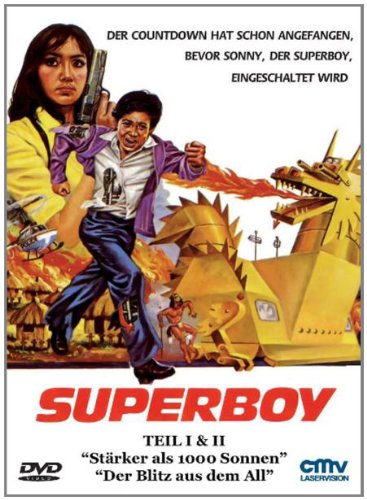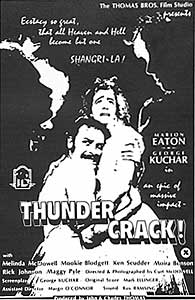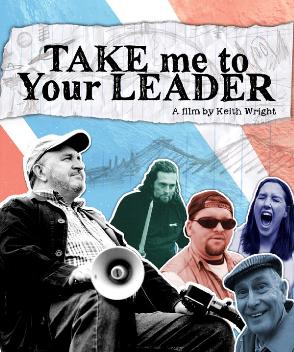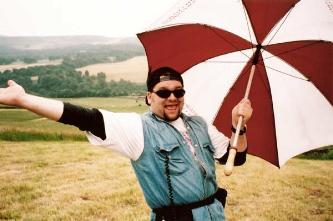Mark Withers, director of Hardcore: A Poke into the Adult Film Orifice, kindly answered one of my six-question mini-interviews in October 2007.
How autobiographical is Hardcore?
“69 per cent! They say the easiest subjects to write about are those you have first hand experience of. Now my experience with the adult film industry goes as far as writing some scripts for that market, but soon feeling like I was really scraping the bottom of the barrel, just as Jack does in the film.
“So that feeling became the springboard for me writing Hardcore. At the time I had fifteen years’ worth of filmmaking experience to draw upon – therefore quite a bit of the script became somewhat autobiographical, even if it was an exaggerated truth of past events.
“I hope I’m a better filmmaker than Jack, but we both started off making dodgy horrors and films with friends at a young age, even if I wasn’t privileged enough to gain access to a video camera until quite a bit older than my fictionalised alter ego! When his Mum reveals that as a boy Jack had a VCR he made out of an old cardboard box – that was me. Some of the crew members are based upon people I’ve worked with and met, especially the egotistical cinematographers. Reg and Ron are based upon two ‘scrap dealers’ I vaguely knew years ago, one of whom was gay despite being a man you really wouldn’t want to cross – so they aren’t, as many people think, influenced by the Kray twins. Plus there are other little bits and pieces that are an extension of me. I’m not as sexually naïve as Jack I must point out though! Honest.”
What are the practical differences between shooting a regular film and a mockumentary?
“Time! With the exception of two or three scenes, they’re all shot in one unbroken take – as a real documentary would be captured, even if sometimes multiple cameras are used and cuts made. Therefore rather than a lot of set-ups, an entire scene can be shot in one go. The first week on location, which was all the footage in the mansion where they’re shooting Assanova, we had six days to film 46 scenes! And we did it. Because really there were 46 set ups, well more like 60 because certainly two scenes at least were shot broken up as if the documentary crew had two cameras running, although we only had one.
“The choice of camera also swayed the decision to make a faux documentary. We had a high definition Sony Z1; initially I’d wanted to use 16mm (the original documentary gauge) but couldn’t raise enough money to afford it. I hadn’t particularly liked video before, but the high def footage I’m very pleased with, although I was under no illusion that it was celluloid, so the video medium was utilised accordingly to film it as a documentary, as so many docs are now shot on tape as opposed to film.
“Our crew was kept small as a ‘real’ documentary would be. I think there were seven or eight of us, sometimes just four covering the bare bone basics of filmmaking.
“None of this was done as an ‘easy option’ though. We knew our budget was tight, as was time (a four week shoot) so I approached it slightly differently from prior films I’d made and also I was directing it ‘in character’ playing the fictional documentarian Linda Boreman, who is also a woman, whereas I am not! So technically it was harder as these long takes, especially where there are a dozen or so people in the scene, were very carefully choreographed whilst trying to make it all look natural without any pre-design, just happening spontaneously then and there for the first time.
“Our week’s worth of rehearsal time before shooting was vital to pull this off on location and not waste precious time. We had a day-by-day shooting schedule and even if we got off to a late start we always finished on or before the scheduled wrap time. It was the best shoot I’ve ever had, despite certain problems arising from two dozen relative strangers cooped up in a mansion in the middle of nowhere for six days.”
How did you assemble your cast and crew?
“We, I keep referring to ‘we’ - that’s myself and co-producer Mike King - put out a casting call on several actor websites. We had a huge response and whittled down our favourites to attend an audition at the Three Mills Studio in London, then a second bout and call-backs two months later.
![]() “Casting had to be ‘spot on’, it was the most important element to me as we were making what on the surface was supposed to be a genuine documentary, so anyone that couldn’t act natural was no use because the game was over as soon as someone looked to be ‘acting’.
“Casting had to be ‘spot on’, it was the most important element to me as we were making what on the surface was supposed to be a genuine documentary, so anyone that couldn’t act natural was no use because the game was over as soon as someone looked to be ‘acting’.
“Jack Innov had to be a character we believed in and liked as he really would carry the film and if an audience didn’t warm to him I don’t think they’d care too much about his endeavour. There were four serious options for Jack, then it became between two – Al Constantine, who we eventually went with, and Tom Clutterbuck, who ended up playing ‘Tinto’. Tom had a different kind of take on Jack which was much more academic and he intellectualised him almost to a point of pretension, which is how so many filmmakers come across as anyway, and they’re usually the ones making the worst films! He also had that film student look, long hair, big beard and I didn’t want Jack to be the cliché we see time after time.
“Al however had a playfulness about him and a real ‘puppy dog’ look that I knew would make audiences sympathetic toward him. He did a really great job – in fact everyone did, I can’t say there’s one performance I’m unhappy with, which is unusual. There were times when I thought we’d miscast, but then it just sort of came right, sometimes at the eleventh hour!
“Also to maintain that ‘air of authenticity’ I wanted to only cast good but mostly unknown actors. This definitely works for the film, but has backfired as far as gaining faith from distributors to release it, as there’s no ‘name’ to sell it on.
“I also mostly cast against type. If I saw a showreel where the actor seemed to be playing a certain type again and again, such as an action star, I’d cast him or her in a role that was either a lot closer to their real personality or someone vastly different. By doing that I can tell that Hardcore is the best work many of them have done to date. Helped of course by such a great script!”
How did the cast and crew cope with all the nudity?
“Very well. We were all adults and it was no big deal, they knew what they were getting themselves into. I am surprised I never had to get naked myself, you know just to ‘encourage’ them. But I didn’t.
“I was marginally concerned on the first day that one of the actresses might ‘bottle out’ as she seemed quite shy, so I made sure we shot her scenes first; a clothed interview and then a nude scene to get her comfortable with it and be sure she would do what she’d promised to do! Because after day one she had another two nude scenes to complete. But she did it with no problem, and as it turns out that actress ended up with the most amount of screen nudity and a little over two years later married me!
“The men wore socks on their cocks, which actually looked funnier than if they were naked and ‘cold’. But as we’d stressed early on that this would be a boobs and bums film with all genitalia ‘fuzzed out’, the sock issue wasn’t a problem.
“At the end of the day, let’s just say the nudity made for a nicer day at the office but still just another day at the office. The trick is, keep looking the actors in the eye! And for me at least I’m so focussed on other things that whether an actor is standing before me naked or not is one of the last things I’m concerned with. Although I do make sure the actors are comfortable and as unembarrassed as possible, otherwise their discomfort will just show through in the end film.”
What has the response to the film been like so far?
“Really good. As a comedy you’re never too sure what works or not after a while because what was once funny has been seen so many times it becomes diluted, so it’s then up to an audience seeing it with fresh eyes to laugh (or not) and remind you that what you did was funny.
“It’s played at several worldwide festivals, the film does translate comedically - even with subtitles. It plays to packed out audiences, mostly males, until word gets around that it isn’t that ‘rude’ and then we get a much more even mix of both sexes turning up.
“At the Cannes market screening we sold out the cinema and despite maybe eight or ten buyers leaving within the first ten minutes (they know that soon if it’s suitable for their company or not) we had other viewers still queuing to get in who were then allocated those vacant seats, so the whole screening remained full to capacity! Which is quite something considering the day before I’d witnessed a much more prolific film producer’s latest offering have some of its audience walk out and stay out within the first half hour!
“Ultimately I made Hardcore for audiences and they really like it. I remember at a screening in Switzerland looking up at the 150 strong crowd whilst the film was playing and I could not see a single non-smiling face. I just wish a reputable distributor would have as much faith in the project and forget all this selling it on a ‘name’ business.”
What are your plans for the future?
“As far as Hardcore is concerned I’m now trying to raise additional funds to do a few things with it. First, get a ‘name’ actress to give a ‘to camera’ opening introduction in the role of fictionalised documentarian Linda Boreman – as she’s never seen in the film, only heard. Then we have our ‘name’ distributors so dearly need! That said, the other thing I want to do is release it on DVD with myself (Big Brush Films) as the distributor.
“Possibly I’d like to get a 35mm print made as that opens up the doors to more independent cinemas taking an interest in screening it, as currently there’s only a digital master. I may also marginally cut a few scenes down, only by two or three minutes at most (we do have 30 minutes’ worth of ‘Circumcised Scenes’ to go on the DVD version, some of which are great) and possibly rename it Blue Movie with the subheading ‘Linda Boreman’s Poke into the Adult Film Orifice’.
“Away from Hardcore I’m struggling along as a freelance filmmaker; I’ve just directed a commercial for Manchester United and am developing my fourth feature length film Baby Swipes, to hopefully shoot in 2009. I’m also making a follow-up to the short My Mum the Wrestler next week, entitled My Dad Made a Seagull - as that little film’s done far better than anything else I ever directed and it only cost me £40 and one day to produce!”
website: bigbrushfilms.moonfruit.com
How autobiographical is Hardcore?
“69 per cent! They say the easiest subjects to write about are those you have first hand experience of. Now my experience with the adult film industry goes as far as writing some scripts for that market, but soon feeling like I was really scraping the bottom of the barrel, just as Jack does in the film.
“So that feeling became the springboard for me writing Hardcore. At the time I had fifteen years’ worth of filmmaking experience to draw upon – therefore quite a bit of the script became somewhat autobiographical, even if it was an exaggerated truth of past events.
“I hope I’m a better filmmaker than Jack, but we both started off making dodgy horrors and films with friends at a young age, even if I wasn’t privileged enough to gain access to a video camera until quite a bit older than my fictionalised alter ego! When his Mum reveals that as a boy Jack had a VCR he made out of an old cardboard box – that was me. Some of the crew members are based upon people I’ve worked with and met, especially the egotistical cinematographers. Reg and Ron are based upon two ‘scrap dealers’ I vaguely knew years ago, one of whom was gay despite being a man you really wouldn’t want to cross – so they aren’t, as many people think, influenced by the Kray twins. Plus there are other little bits and pieces that are an extension of me. I’m not as sexually naïve as Jack I must point out though! Honest.”
What are the practical differences between shooting a regular film and a mockumentary?
“Time! With the exception of two or three scenes, they’re all shot in one unbroken take – as a real documentary would be captured, even if sometimes multiple cameras are used and cuts made. Therefore rather than a lot of set-ups, an entire scene can be shot in one go. The first week on location, which was all the footage in the mansion where they’re shooting Assanova, we had six days to film 46 scenes! And we did it. Because really there were 46 set ups, well more like 60 because certainly two scenes at least were shot broken up as if the documentary crew had two cameras running, although we only had one.
“The choice of camera also swayed the decision to make a faux documentary. We had a high definition Sony Z1; initially I’d wanted to use 16mm (the original documentary gauge) but couldn’t raise enough money to afford it. I hadn’t particularly liked video before, but the high def footage I’m very pleased with, although I was under no illusion that it was celluloid, so the video medium was utilised accordingly to film it as a documentary, as so many docs are now shot on tape as opposed to film.
“Our crew was kept small as a ‘real’ documentary would be. I think there were seven or eight of us, sometimes just four covering the bare bone basics of filmmaking.
“None of this was done as an ‘easy option’ though. We knew our budget was tight, as was time (a four week shoot) so I approached it slightly differently from prior films I’d made and also I was directing it ‘in character’ playing the fictional documentarian Linda Boreman, who is also a woman, whereas I am not! So technically it was harder as these long takes, especially where there are a dozen or so people in the scene, were very carefully choreographed whilst trying to make it all look natural without any pre-design, just happening spontaneously then and there for the first time.
“Our week’s worth of rehearsal time before shooting was vital to pull this off on location and not waste precious time. We had a day-by-day shooting schedule and even if we got off to a late start we always finished on or before the scheduled wrap time. It was the best shoot I’ve ever had, despite certain problems arising from two dozen relative strangers cooped up in a mansion in the middle of nowhere for six days.”
How did you assemble your cast and crew?
“We, I keep referring to ‘we’ - that’s myself and co-producer Mike King - put out a casting call on several actor websites. We had a huge response and whittled down our favourites to attend an audition at the Three Mills Studio in London, then a second bout and call-backs two months later.
 “Casting had to be ‘spot on’, it was the most important element to me as we were making what on the surface was supposed to be a genuine documentary, so anyone that couldn’t act natural was no use because the game was over as soon as someone looked to be ‘acting’.
“Casting had to be ‘spot on’, it was the most important element to me as we were making what on the surface was supposed to be a genuine documentary, so anyone that couldn’t act natural was no use because the game was over as soon as someone looked to be ‘acting’.“Jack Innov had to be a character we believed in and liked as he really would carry the film and if an audience didn’t warm to him I don’t think they’d care too much about his endeavour. There were four serious options for Jack, then it became between two – Al Constantine, who we eventually went with, and Tom Clutterbuck, who ended up playing ‘Tinto’. Tom had a different kind of take on Jack which was much more academic and he intellectualised him almost to a point of pretension, which is how so many filmmakers come across as anyway, and they’re usually the ones making the worst films! He also had that film student look, long hair, big beard and I didn’t want Jack to be the cliché we see time after time.
“Al however had a playfulness about him and a real ‘puppy dog’ look that I knew would make audiences sympathetic toward him. He did a really great job – in fact everyone did, I can’t say there’s one performance I’m unhappy with, which is unusual. There were times when I thought we’d miscast, but then it just sort of came right, sometimes at the eleventh hour!
“Also to maintain that ‘air of authenticity’ I wanted to only cast good but mostly unknown actors. This definitely works for the film, but has backfired as far as gaining faith from distributors to release it, as there’s no ‘name’ to sell it on.
“I also mostly cast against type. If I saw a showreel where the actor seemed to be playing a certain type again and again, such as an action star, I’d cast him or her in a role that was either a lot closer to their real personality or someone vastly different. By doing that I can tell that Hardcore is the best work many of them have done to date. Helped of course by such a great script!”
How did the cast and crew cope with all the nudity?
“Very well. We were all adults and it was no big deal, they knew what they were getting themselves into. I am surprised I never had to get naked myself, you know just to ‘encourage’ them. But I didn’t.
“I was marginally concerned on the first day that one of the actresses might ‘bottle out’ as she seemed quite shy, so I made sure we shot her scenes first; a clothed interview and then a nude scene to get her comfortable with it and be sure she would do what she’d promised to do! Because after day one she had another two nude scenes to complete. But she did it with no problem, and as it turns out that actress ended up with the most amount of screen nudity and a little over two years later married me!
“The men wore socks on their cocks, which actually looked funnier than if they were naked and ‘cold’. But as we’d stressed early on that this would be a boobs and bums film with all genitalia ‘fuzzed out’, the sock issue wasn’t a problem.
“At the end of the day, let’s just say the nudity made for a nicer day at the office but still just another day at the office. The trick is, keep looking the actors in the eye! And for me at least I’m so focussed on other things that whether an actor is standing before me naked or not is one of the last things I’m concerned with. Although I do make sure the actors are comfortable and as unembarrassed as possible, otherwise their discomfort will just show through in the end film.”
What has the response to the film been like so far?
“Really good. As a comedy you’re never too sure what works or not after a while because what was once funny has been seen so many times it becomes diluted, so it’s then up to an audience seeing it with fresh eyes to laugh (or not) and remind you that what you did was funny.
“It’s played at several worldwide festivals, the film does translate comedically - even with subtitles. It plays to packed out audiences, mostly males, until word gets around that it isn’t that ‘rude’ and then we get a much more even mix of both sexes turning up.
“At the Cannes market screening we sold out the cinema and despite maybe eight or ten buyers leaving within the first ten minutes (they know that soon if it’s suitable for their company or not) we had other viewers still queuing to get in who were then allocated those vacant seats, so the whole screening remained full to capacity! Which is quite something considering the day before I’d witnessed a much more prolific film producer’s latest offering have some of its audience walk out and stay out within the first half hour!
“Ultimately I made Hardcore for audiences and they really like it. I remember at a screening in Switzerland looking up at the 150 strong crowd whilst the film was playing and I could not see a single non-smiling face. I just wish a reputable distributor would have as much faith in the project and forget all this selling it on a ‘name’ business.”
What are your plans for the future?
“As far as Hardcore is concerned I’m now trying to raise additional funds to do a few things with it. First, get a ‘name’ actress to give a ‘to camera’ opening introduction in the role of fictionalised documentarian Linda Boreman – as she’s never seen in the film, only heard. Then we have our ‘name’ distributors so dearly need! That said, the other thing I want to do is release it on DVD with myself (Big Brush Films) as the distributor.
“Possibly I’d like to get a 35mm print made as that opens up the doors to more independent cinemas taking an interest in screening it, as currently there’s only a digital master. I may also marginally cut a few scenes down, only by two or three minutes at most (we do have 30 minutes’ worth of ‘Circumcised Scenes’ to go on the DVD version, some of which are great) and possibly rename it Blue Movie with the subheading ‘Linda Boreman’s Poke into the Adult Film Orifice’.
“Away from Hardcore I’m struggling along as a freelance filmmaker; I’ve just directed a commercial for Manchester United and am developing my fourth feature length film Baby Swipes, to hopefully shoot in 2009. I’m also making a follow-up to the short My Mum the Wrestler next week, entitled My Dad Made a Seagull - as that little film’s done far better than anything else I ever directed and it only cost me £40 and one day to produce!”
website: bigbrushfilms.moonfruit.com














































































































